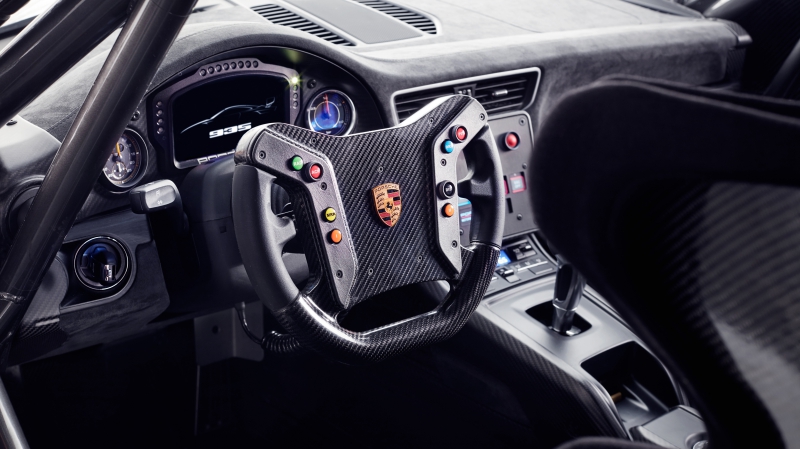Just when we thought that Porsche’s 70th anniversary party couldn’t get any grander, with the unveiling of the delectable 911 Speedster concept and a “brand-new” 1998 911 Turbo, it seems that the boys at Zuffenhausen have been saving the best for last with the surprise debut of a brand new clubsport Porsche known as the “935”.

Though basically a re-bodied 911 GT2 RS with more body thanks to its massive aerodynamic tail that stretches its body to 4.86 metres, coupled to the same amount of go from its 515kW 3.8-litre blown flat-six, a little less weight at 1380kg, and just 77 examples being made, the 935 is more than just a badge job.
With no limitations for road-legality or racing homologation purposes, Porsche’s engineers certainly went wild with its design. Gone are the stock 911 GT2 RS’ headlights, whereas the front fairings are lifted off a 911 GT3 R race car to deliver increased levels of downforce, the turbofan wheels are reminiscent of the great 70’s racing wheels, the massive rear wing’s endplates LED lights were adopted from a 919 Hybrid LMP1 race car, whereas the titanium exhausts are modelled after Porsche’s 908 race cars of the 60’s.

On the inside, the gear knob features laminated wood, a throwback to the 917, 909 Bergspyder, and the Carrera GT, whereas the steering wheel is lifted straight off the 911 GT3 R race car, and a passenger seat is now only an optional extra. All things considered, the 935 is the ultimate tribute to Porsche’s motorsports past and present, with particular honours given to the 1978 935/78 race car, which is better known to motorsports fans by its nickname, the “Moby Dick”.
The original “Moby Dick” had an interesting history, it was to be the swansong of the 935 race car that was bred for Group 5 special production car racing that commenced the glorious era of “silhouette” race cars – where conforming to a loose definition of “shape” were the only barrier for entry – and pull all the stops Porsche did.

Porsche’s motorsports engineer – and father of the 935 – Norbert Singer went to town with the 935/78, delving into his background as an aeronautical engineer to stretch the rulebook at every page as far as possible. He stretched the rear bodywork so much that the car had an exterior rear window over the original production window to comply with the rules, his interpretation of a regulation review for exhaust exits saw the “Moby Dick” lowered by another 8cm, and since most European tracks ran in a clockwise direction the seating position too was punted over to the right.
With its immense length and girth, ground-hugging stance, and white body colour during preparation, an unnamed mechanic mentioned that it looked like the eponymous white whale of the literary classic “Moby Dick”, and that passing quip stuck. While it looked like a whale, the “Moby Dick” was anything but one.
At its first race at the Silverstone 6 Hours, drivers Jacky Ickx and Jochen Mass started a wet race on pole and powered through to take the chequered flag, seven laps ahead of its nearest rival. Unfortunately for Porsche, their Silverstone win was going to be the only trophy the “Moby Dick” brought home.

Even though the car achieved a record top speed of 366km/h at the 24 Hours of Le Mans, blasting prototype racers into the weeds along the way, it never did translate its outright pace into an endurance victory. Its 3.2-litre turbocharged flat-six that pumped out 559kW had a voracious appetite that force the drivers to pit 32 times for fuel. Coupled with a small oil leak and a puncture, the 935/78 couldn’t clock in the laps to clinch the top honours.
Porsche continued to campaign the “Moby Dick” another two more times at the Vallelunga 6 Hours and ADAC Norisring Trophy, both of which ended with a DNF as the car blew a fuel injection belt in the last 15 minutes of the Vallelunga race and encountered brake problems just 14 laps into the Norisring race.
With the end of the 1978 season, the brief career of the “Moby Dick” came to a close, as Porsche chose to stay away from sports car racing for the 1979 and 1980 season while they awaited rule changes and the introduction of Group C racing in 1982.

Considering the dominant track record of the 935 series racers, the “Moby Dick” wasn’t quite the blaze of glory Porsche had hoped to see off the 935. Rather ironically, like the white whale of Herman Melville’s novel, its iconic name and looks gave it a more literary connection. Its conception, which was spurred on by the monomania of achieving all out motorsports glory was a fitting analogy to the literary “Moby Dick”, which in itself was not only the source of Captain Ahab’s ire and desire for revenge, but symbolised the uncontrollable and unpredictable mysteries of existence, God, and the cosmos.
Despite Porsche’s best efforts, the short and beleaguered racing history of the “Moby Dick” was an anti-climatic end to Porsche’s campaign for the 935, but on the flip side, its unforgettable and indomitable shape left an everlasting impression on motorsports and Porsche fans around the world that its checkered past matter little, as demonstrated by the sheer fanfare surrounding the new 935’s debut. The way to which it won our hearts and captivated our imagination effortlessly without clinching top honours is a poetic change of fortunes that few could have scripted better.


